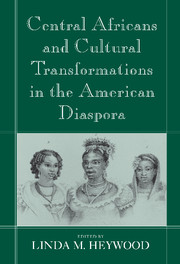Book contents
- Frontmatter
- Contents
- List of Contributors
- Foreword
- Acknowledgments
- Introduction
- PART ONE CENTRAL AFRICA: SOCIETY, CULTURE, AND THE SLAVE TRADE
- PART TWO CENTRAL AFRICANS IN BRAZIL
- 4 Central Africans in Central Brazil, 1780–1835
- 5 Who Is the King of Congo? A New Look at African and Afro-Brazilian Kings in Brazil
- 6 The Great Porpoise-Skull Strike: Central African Water Spirits and Slave Identity in Early-Nineteenth-Century Rio de Janeiro
- PART THREE CENTRAL AFRICANS IN HAITI AND SPANISH AMERICA
- PART FOUR CENTRAL AFRICANS IN NORTH AMERICA AND THE CARIBBEAN
- Index
6 - The Great Porpoise-Skull Strike: Central African Water Spirits and Slave Identity in Early-Nineteenth-Century Rio de Janeiro
Published online by Cambridge University Press: 28 October 2009
- Frontmatter
- Contents
- List of Contributors
- Foreword
- Acknowledgments
- Introduction
- PART ONE CENTRAL AFRICA: SOCIETY, CULTURE, AND THE SLAVE TRADE
- PART TWO CENTRAL AFRICANS IN BRAZIL
- 4 Central Africans in Central Brazil, 1780–1835
- 5 Who Is the King of Congo? A New Look at African and Afro-Brazilian Kings in Brazil
- 6 The Great Porpoise-Skull Strike: Central African Water Spirits and Slave Identity in Early-Nineteenth-Century Rio de Janeiro
- PART THREE CENTRAL AFRICANS IN HAITI AND SPANISH AMERICA
- PART FOUR CENTRAL AFRICANS IN NORTH AMERICA AND THE CARIBBEAN
- Index
Summary
In late December 1816, the English merchant and amateur naturalist John Luccock left the city of Rio de Janeiro for a boat “excursion to the upper [part of Guanabara] Bay” (the water on which the city fronted) and to “the rivers falling into it.” After several days of travel on a launch captained by a Portuguese sailor and manned by “four stout negroes,” he put in to a harbor on one of the bay's many small islands. En route, his interest in geology had made him especially sensitive to the spectacular meeting of mountain and water that characterizes the environs of Rio. His account of the experience abounds in descriptions of tall waterfalls, wide and deep rivers, and extraordinary rock formations, the latter seemingly becoming all the more fantastic as the launch approached the island.
Once on land in the small harbor, Luccock witnessed – indeed, precipitated – a small insurrection. The boat's crew suddenly refused to work, for reasons which the merchant-naturalist simply could not comprehend. “Within the pier, about two months before,” he writes, “I had seen a dead porpoise, then in a very offensive state. The skeleton being now dry and clean, I took up the skull and threw it into the boat, intending to examine it at leisure.” Shortly thereafter, when the participants in the excursion were about to reboard the launch, “it appeared that the skull was an object of superstitious dread to our negroes, who thought it a human one, and imagined that it had belonged to a person of their own colour: – the resemblance certainly gave some ground for the suspicion.”
- Type
- Chapter
- Information
- Publisher: Cambridge University PressPrint publication year: 2001
- 2
- Cited by



